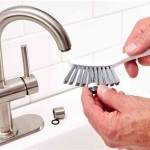Ada Bathroom Layout Dimensions: A Guide to Accessible Design
Designing an accessible bathroom is crucial for creating a space that is both functional and comfortable for individuals with disabilities. The Americans with Disabilities Act (ADA) provides guidelines for bathroom layout dimensions, ensuring that these spaces meet the needs of a diverse population. Adhering to these standards not only promotes inclusivity but also enhances safety and ease of use for all individuals. Understanding the key elements of ADA bathroom layout dimensions is essential for architects, designers, and anyone involved in building or renovating bathrooms.
Doorway Width and Clearance
One of the most fundamental aspects of accessible bathroom design is ensuring adequate doorway width and clearance. According to ADA standards, doorways should be at least 32 inches wide to accommodate wheelchairs and assistive devices. This clearance allows for comfortable passage and maneuverability within the bathroom space. To further enhance accessibility, the doorway should swing outward, eliminating the risk of the door blocking the entrance.
Turning Radius and Maneuvering Space
Beyond the doorway, the bathroom layout must provide ample turning radius and maneuvering space for individuals using wheelchairs or other mobility devices. The ADA guidelines stipulate a minimum turning radius of 60 inches, allowing for safe and efficient movement within the bathroom. This means that there should be sufficient room for a wheelchair to turn around without hitting any fixtures or walls. Additionally, all areas within the bathroom should provide at least 36 inches of clear floor space, enabling comfortable access and use of all amenities.
Fixture Placement and Height
Accessible bathroom design also emphasizes the proper placement and height of fixtures such as toilets, sinks, and showers. Toilets should be positioned with a clear floor space of 30 inches in front and 18 inches on either side. Ideally, toilets should be wall-mounted or have a back wall that is easily accessible, facilitating transfers for individuals with limited mobility. Sinks should be mounted at a height of 34 inches from the floor, allowing users to comfortably wash their hands without straining. Shower stalls should be at least 36 inches wide and have a seat, providing a safe and stable environment for bathing. The shower head should be adjustable and mounted at a height of 48 inches from the floor, allowing for comfortable and flexible positioning.
Grab Bars and Handrails
Grab bars and handrails are essential components of accessible bathroom design, providing support and stability for individuals with mobility impairments. ADA standards require the installation of grab bars in various locations, including near the toilet, shower, and tub. These bars should be placed at a height of 33-36 inches above the floor, ensuring easy reach and a secure grip. The bars should also be able to withstand a weight load of at least 250 pounds. Handrails should be installed along walls and walkways, providing additional support and guidance for users navigating the space.
Accessible Controls and Faucets
To ensure ease of use, all bathroom controls and faucets should be accessible to individuals of varying abilities. Faucets should be lever-style or push-button activated, allowing for manipulation without requiring significant hand strength or dexterity. Thermostat controls for showers should be located within easy reach, ideally at a height of 48 inches from the floor. These accessible controls promote independence and ease of use for all bathroom users.
Additional Considerations
In addition to the specific dimensions outlined above, there are a number of other considerations for creating accessible bathroom layouts. These include: *
Non-slip surfaces:
Floors and shower surfaces should have a slip-resistant finish to prevent accidents, particularly for individuals with mobility impairments. *Proper lighting:
Ample lighting is crucial for safety and visibility, especially in the shower and around the toilet. *Accessible storage:
Shelving and cabinetry should be placed at accessible heights, allowing individuals with limited reach to access their belongings. *Clear pathways:
All pathways should be wide and clear, free of any obstructions or obstacles that could impede passage. *Communication devices:
Installing visual or auditory alarms in case of emergencies can enhance safety and provide peace of mind. By carefully considering these factors, designers and builders can create bathroom spaces that are truly accessible and welcoming for all individuals.Ada Accessible Single User Toilet Room Layout And Requirements Rethink Access Registered Accessibility Specialist Tdlr Ras

Ada Bathroom Layout Commercial Restroom Requirements And Plans

Ada Bathroom Layout Commercial Restroom Requirements And Plans

Designing Your Ada Compliant Restroom Crossfields Interiors Architecture

Pin On Kress 2 Ti

Chapter 6 Toilet Rooms

Ada Inspections Nationwide Llc Compliancy

Pin On Bath Proyects

Ada Bathroom Requirements Toilet Partitions

I M Renovating My Office Does The Existing Bathroom Need To Be Ada Compliant Helping Nyc Long Island Commercial Tenants Owners And Developers
Related Posts







